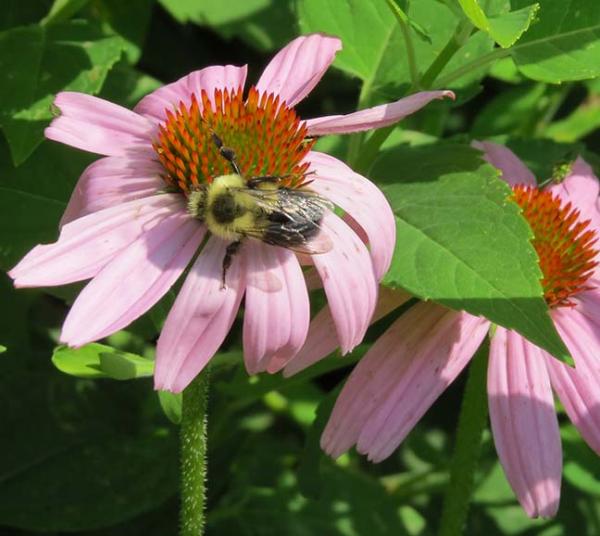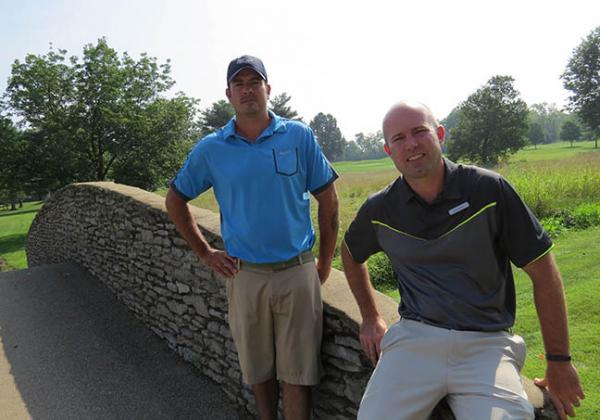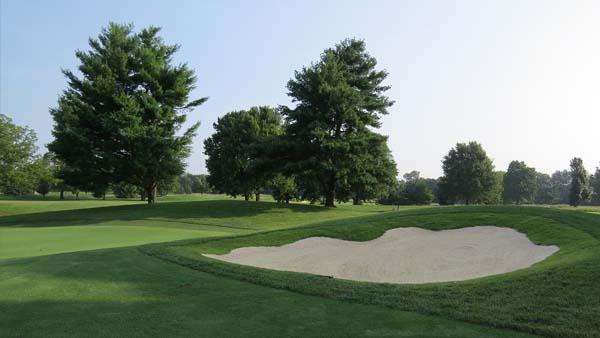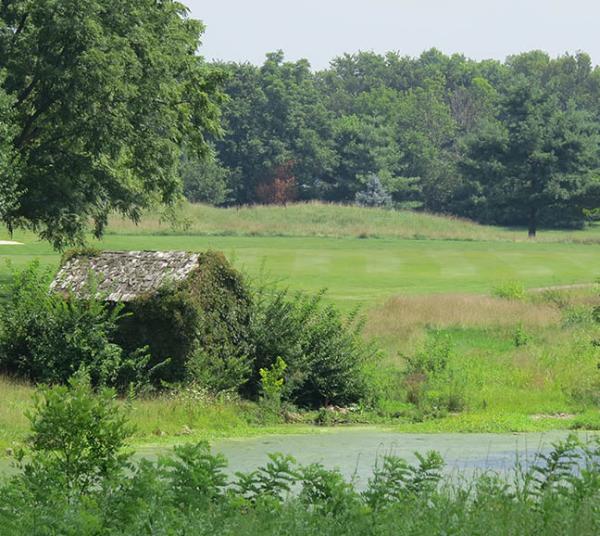 Looks can be deceiving when driving past Griffin Gate Golf Club. Other than a sign that directs traffic toward this Marriott resort course in Lexington, Kentucky, there is little evidence from the outside that such a peaceful place could exist wedged into a corner formed by six lanes of traffic-snarled Newtown Pike and as many lanes of the always-busy Interstate 75.
Looks can be deceiving when driving past Griffin Gate Golf Club. Other than a sign that directs traffic toward this Marriott resort course in Lexington, Kentucky, there is little evidence from the outside that such a peaceful place could exist wedged into a corner formed by six lanes of traffic-snarled Newtown Pike and as many lanes of the always-busy Interstate 75.
Once one makes the turn and begins the slow, uphill climb toward the golf course, the hustle and bustle gradually give way to a feeling of serenity that is almost surreal given the location. In a sea of traffic that steadily has been engulfing Kentucky's Bluegrass Region for the past 35 years, Griffin Gate is an oasis.
"That's what I compare it to," said Zach Newell, who is in his third season as superintendent. "You go from urban sprawl, Newtown and (I-)75, and then you come in here. It's pretty amazing."
A former stop on the PGA Senior Tour, the 1981 Rees Jones design has developed a reputation in recent years for being a blueprint for environmental stewardship. That journey largely is one that began in 2002 when Scott Bender, CGCS, arrived here. And it's one that continues today under Newell.
Griffin Gate is located on 185 acres of what once was one of Lexington's trademark thoroughbred horse farms. Everything about the property belies its location while Kentucky's second-largest city continues to grow up around it. Even the farm's 19th century mansion home, built in 1873 after the original residence erected in 1854 was destroyed by fire, still is located here.
A 2000 University of Kentucky graduate, Bender, 39, prepped for two years under Mark Wilson at Valhalla Golf Club in Louisville, before returning to his hometown in 2002 to become superintendent at Griffin Gate.
"It was nice to come back home to Lexington to work," Bender said. "In this business, you never know where you're going to end up."

During Bender's tenure as superintendent, Griffin Gate became a certified Audubon sanctuary in 2008 and was a pilot facility for the e-Par environmental certification program. His work toward achieving Audubon certification included erecting boxes to attract bluebirds and bats, and establishing areas that have helped attract other forms of wildlife to this urban environment.
In 2013, with help from UK's entomology department headed by former USGA Green Section Award winner Dan Potter, Ph.D., Bender established the first of two pollinator zones on the golf course.
"We worked with the department of fish and wildlife and established wildlife corridors on the property where animals can pass through," Bender said. "We established two areas of butterfly gardens. It was great working with UK. Whenever they want land here, I'll find them a spot to do things like this."
Since then, Bender has been named the property's director of engineering and grounds, giving him the responsibility of overseeing not only the golf course, but the property's 409-room, 350,000-square-foot hotel as well. Newell, his assistant for two years, is in his third season as course superintendent, but make no mistake, Bender still is at home on the golf course. His philosophy of environmental stewardship now permeates the entire property and includes resource-conserving measures inside at the hotel and outdoors on the golf course.
"I love it out here," he said. "It's always welcome when I can get back out on the golf course."
Just about everything that happens on the golf course at Griffin Gate likely will accomplish at least one of three goals ? improve the golf course for Marriott customers, maximize profitability for the hotel and make more efficient use of resources. Often, a project can accomplish all three goals at once.

On July 23, the course celebrated a grand reopening after a four-month bunker renovation projected headed by Jones promises to improve playability for a wider range of golfers and more friendly to Griffin Gate's maintenance budget.
Although the bunker count was reduced by only two, from 69 to 67, Jones took out about 53,000 square feet of hazard. Areas that once were filled with sand now are covered with zoysia sod. Nearly 400,000 square feet of it have been used during the project.
"We went from 133,000 square feet of bunkers, which is just enormous, to around 80,000 square feet," Bender said. "There were some silly large bunkers that were not in play."
Since Griffin Gate opened nearly 35 years ago, bunkers there were, as Bender described, like a catcher's mitt, nearly surrounding every green on the course with high, flashing sides that were difficult to maintain.
"When we'd have rain events, we'd spend the next three days trying to recover from that," he said.
Shaving down those sides has opened up views across the golf course.
Griffin Gate's bunkers not only are smaller now, the high, flashed sides are gone. Couple that with the installation of Better Billy Bunker system, at Bender's request, and post-rain event bunker maintenance suddenly has become almost a thing of the past.
With a combined 24 inches of rain falling in June and July at Griffin Gate, Bender shudders to think what the course would look like this year without a bunker renovation.
"It has been crazy wet this year. We're finding water in places we never had it before," he said. "If we didn't go with a liner, the bunkers would have been ruined before we opened, we had that much rain."
Weather also provided predictable challenges during the project.

Temperatures in Lexington reached 60 degrees on March 3 and 50 degrees the following day, according to the National Weather Service, more than enough to get winter-weary golfers back onto the course. By the night of March 4, temperatures dropped into the 20s and 17 inches of snow fell during the next 36 hours. Then came the rain.
"We would seed, and the rain would wash it off," Newell said. "We paid to hydroseed, and the rain washed it off."
From horseshoe teemarkers to 150-yard markers fashioned from old hitching posts, links to Griffin Gate's past are everywhere. Perhaps the property's most important legacy is Bender's minimalist philosophy.
He's instituted use of LCD bulbs throughout the hotel, a policy that Newell is taking to buildings around the golf course, as well as an extensive recycling program. Next up are sensors in restrooms so lights are on only when needed.
"Our first fairway app usually isn't until June," Bender said. "We'll grow some dollar spot before we freak out. We really watch the weather, and we'll stretch our fairway apps as much as we can to get a three-week spray, or even longer.
"Our philosophy here is to go green, and economics is a big part of that."

